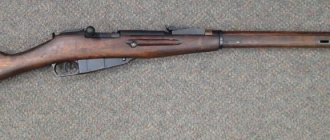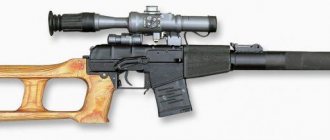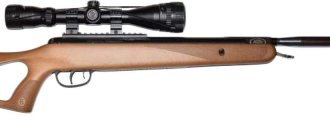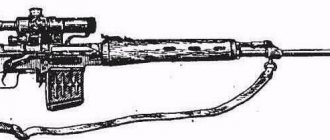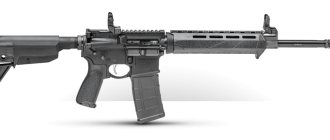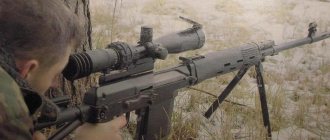| : Incorrect or missing image | To improve this article it is desirable:
|
| |
| Type: | |
| A country: | USA |
| Service history | |
| Years of operation: | 1869—1908, 1871—1888 |
| In service: | USA, Ottoman Empire, Great Britain, etc. |
| Wars and conflicts: | Colonial Wars of the British Empire, Bosnian-Herzegovinian Rebellion, Russo-Turkish War (1877–1878), Anglo-Zulu War, 1st Greco-Turkish War, Balkan Wars, First World War, 2nd Greco-Turkish War, Afghan War (1979-1989), etc. |
| Production history | |
| Years of production: | 1869—1871 1871—1889 |
| Options: | Martini-Henry rifle Martini-Mauser rifle 1908 |
| Characteristics | |
| Weight, kg: | 3,8 |
| Length, mm: | 1250 |
| Cartridge: | .577/450 Martini-Henry |
| Caliber, mm: | 11.43 |
| Work principles: | swing shutter |
| Sighting range, m: | 1183 |
| Images on Wikimedia Commons: | [1] |
Peabody-Martini RiflePeabody-Martini
RiflePeabody-Martini Rifle
- designation of a family of military rifles dating back to a model manufactured in the USA in 1869-1871 by Peabody.
The rifle was sold to the armies of several states and to private individuals. Various modifications, in particular Martini-Henry
, were produced in many countries around the world and were used until the First World War, and occasionally even in the second half of the 20th century. In addition to military use, the rifle was used instead of a large-caliber rifle for hunting particularly large animals, for example, bears.
Design
The rifle is single-shot, its stock is made of high-quality American walnut. The forend had a length of 750 mm; a steel ramrod 806 mm long was placed into it through a longitudinal groove. The butt was reinforced with a steel butt plate with a diamond-shaped notch. It was equipped with a swivel, which was screwed into the wood of the butt, and a latch for the bolt release lever. The bolt was swinging, it was driven by a lower lever, which ensured the opening and closing of the bolt, cocking the firing pin, and removing and ejecting the cartridge case from the rifle using an ejector. Rifle caliber - 11.43 mm, barrel length - 840 mm, total length - 1250 mm. Weight without bayonet - 3800 g, pitch - 560 mm, rate of fire - 10 rounds/min. Rifling system - 7 Henry rifling. The sight is open, stepped-frame, the rear sight for shooting at short distances is wide, saddle-shaped, for more accurate, long-range shooting, there is a movable clamp with a small slot of a triangular cross-section, the front sight is also of a triangular cross-section. The barrel itself is round in shape, firmly screwed into the receiver, and attached to the fore-end by two sliding steel rings on screws. Cross steel round pins are used to prevent the rings from moving. The front swivel is located on the front ring, and the additional one is located in front of the trigger guard. Both swivels are 45mm wide. The trigger has special notches to increase the sensitivity of the finger; the trigger is soft, without warning, and has no free play. After the cartridge is placed in the barrel, it is necessary to close the bolt while keeping the trigger pressed. Then, for instant cocking, all you need to do is pull the cocking lever. The cartridge is not ejected. After the shot, the cartridge case is thrown to the right, up and back when the lower lever is lowered. The buttstock is well attached to the receiver with a clamping screw. The pinch screw holding it in place is covered by a heavy cast buttplate, secured to the wood of the stock with two screws.
Story
During the operation of army rifles, only the infantry did not experience difficulties when loading them through the muzzle. To do this, the shooter just had to put the weapon in a vertical position, pour a certain amount of gunpowder into the barrel, drive a wad and a bullet. Then spray again to prevent the ammunition from rolling back out of the barrel. Problems were observed among horsemen, as well as infantrymen, who were forced to load their rifles in a prone position. The situation was corrected by weapons designer Christian Sharps, who in 1851 developed a vertical wedge sliding in grooves for a rifle. After opening, the breech of the weapon was supplied with a paper cartridge, and was locked using a bolt, which was raised using a special lever. Their connection was provided by a drive. These systems were characterized by high reliability and accuracy.
In 1862, American weapons designer Henry Peabody patented his lever and trigger guard for a rifle.
Ammo
Suitable cartridges include .450 Turkish Peabody, .45 Peabody-Martini and 11.43 x 55R mm Turkish. They have a brass, seamless bottle-shaped sleeve. Case length - 58.42 mm, cartridge length - 79.25 mm, rim diameter - 16.97 mm, case base diameter - 14.78 mm, shoulder diameter - 14.78 mm, neck diameter - 12.04 mm , the weight of the powder charge is 5.18 g, the diameter of the bullet is 11.35 mm, its weight is 31.49 g. The bullet itself is shellless, lead, with a rounded head, wrapped in oiled paper for obturation, since its diameter is less than the diameter of the barrel . A seal is used to equip the cartridge. Wrapping the bullet in oiled paper and using a seal was intended to reduce friction and also prevent excessive lead in the barrel and improve sealing. The gunpowder was smoky. The .45 Peabody-Martini cartridge, produced in the USA, was much better and had good range, accuracy and ballistics.
Japanese model
The system, which operates on the principle of a swinging sliding bolt, has attracted many followers with its simplicity and reliability.
In 1905, Japan developed its own breech-loading rifle using a sliding rotary bolt. In the history of small arms, this model is known as Arisaka.
Since it is very important for infantrymen to have a full-fledged knife on hand during a battle or when setting up a camp, Japanese developers equipped the muzzles of their rifles with needle bayonets. High-quality steel was used in the manufacture of this bladed weapon. Thanks to its high characteristics, these knives were also used by American infantrymen. Like the Peabody-Martini rifles, the Arisaka rifles have served mankind in many wars.
Modifications
British Empire
The British Empire combined the Peabody locking mechanism, the improved percussion mechanism of the Swiss engineer Martini and the polygonal rifling of the Henry barrel. The new rifle was called Martini-Henry. In total, up to a million copies of the four series Mk I-IV were manufactured, which were in service in different parts of the British Empire for more than 30 years, until the end of the First World War. In the second half of the 20th century, Martini-Henry rifles were found among the Afghan Mujahideen during the Afghan War.
Carbines and training models were produced. The conversion of the rifle with the Metford barrel was called the Martini-Metford, and the one with the barrel from the Lee-Enfield rifle was called the Martini-Enfield.
Ottoman Empire
The first batches of Martini-Henry rifles were sent exclusively to supply the British army, therefore, interested in modern weapons, the Ottoman Empire ordered rifles of the original Peabody model from the USA. The rifle was used against Russian troops in the Russo-Turkish War (1877-1878).
Before World War I, it turned out that many Peabody rifles were stored in warehouses, but there was not enough ammunition for them, while Mauser 7.65 mm cartridges were in abundance. The Turkish government ordered the barrels to be replaced with suitable ones. The converted rifle, known as the Martini-Mauser 1908, had a good action and rate of fire. The fatal flaw was survivability: smokeless powder cartridges were too powerful and the receiver became unusable after a few hundred rounds.
System design
The movable bolt was mounted above the center line of the barrel channel. In order to lower the front of the bolt down, the shooter had to move the bracket down and forward. At the same time, the breech was opened to remove the spent cartridge case from the barrel. After these actions, new ammunition was inserted into the breech, and the weapon was again ready to fire.
Thanks to the conveniently located safety lever and the complete absence of other protruding parts on the receiver, this system has been approved in the USA and Europe.
Links
Revolvers Beaumont-Adams • Enfield • Webley Rifles and muskets Brown Bess • Baker • Brunswick • Minier • Enfield arr. 1853 • Snyder-Enfield • Martini-Henry • Lee-Metford • Lee-Enfield Machine guns Nordenfelt • Gatling • Gardner • Maxim canister Artillery Field : QF 1-pounder •
Mountain
: RML 7-pounder •
Siege
: BL 5″ Mk I–V •
Howitzers
: BL 5″Rockets Congreve rocket
Swiss modifications
The Henry Peabody rifle system was improved by the Swiss engineer Frederic von Martini. In his opinion, a serious drawback of the rifle was the presence of an external hammer, which was cocked separately. The Swiss engineer incorporated it into a single mechanism, in which control was still carried out using a lever located behind the trigger guard. The trigger as a spring-loaded striker was placed inside the bolt. The modified system was liked by the British military command, and in 1871 the Peabody-Martini rifle was adopted for service.
Excerpt describing the Peabody-Martini Rifle
The conversation died down. - Mother! what kind of cake will it be? – Natasha’s voice sounded even more decisively, without breaking down. The Countess wanted to frown, but could not. Marya Dmitrievna shook her thick finger. “Cossack,” she said threateningly. Most of the guests looked at the elders, not knowing how to take this trick. - Here I am! - said the countess. - Mother! what kind of cake will there be? - Natasha shouted now boldly and capriciously cheerfully, confident in advance that her prank would be well received. Sonya and fat Petya were hiding from laughter. “That’s why I asked,” Natasha whispered to her little brother and Pierre, whom she looked at again. “Ice cream, but they won’t give it to you,” said Marya Dmitrievna. Natasha saw that there was nothing to be afraid of, and therefore she was not afraid of Marya Dmitrievna. - Marya Dmitrievna? what ice cream! I don't like cream. - Carrot. - No, which one? Marya Dmitrievna, which one? – she almost screamed. - I want to know! Marya Dmitrievna and the Countess laughed, and all the guests followed them. Everyone laughed not at Marya Dmitrievna’s answer, but at the incomprehensible courage and dexterity of this girl, who knew how and dared to treat Marya Dmitrievna like that. Natasha fell behind only when she was told that there would be pineapple. Champagne was served before the ice cream. The music started playing again, the count kissed the countess, and the guests stood up and congratulated the countess, clinking glasses across the table with the count, the children, and each other. Waiters ran in again, chairs rattled, and in the same order, but with redder faces, the guests returned to the drawing room and the count’s office. The Boston tables were moved apart, the parties were drawn up, and the Count's guests settled in two living rooms, a sofa room and a library. The Count, fanning out his cards, could hardly resist the habit of an afternoon nap and laughed at everything. The youth, incited by the countess, gathered around the clavichord and harp. Julie was the first, at the request of everyone, to play a piece with variations on the harp and, together with other girls, began to ask Natasha and Nikolai, known for their musicality, to sing something. Natasha, who was addressed as a big girl, was apparently very proud of this, but at the same time she was timid. - What are we going to sing? – she asked. “The key,” answered Nikolai. - Well, let's hurry up. Boris, come here,” Natasha said. - Where is Sonya? She looked around and, seeing that her friend was not in the room, ran after her. Running into Sonya’s room and not finding her friend there, Natasha ran into the nursery - and Sonya was not there. Natasha realized that Sonya was in the corridor on the chest. The chest in the corridor was the place of sorrow for the younger female generation of the Rostov house. Indeed, Sonya in her airy pink dress, crushing it, lay face down on her nanny’s dirty striped feather bed, on the chest and, covering her face with her fingers, cried bitterly, shaking her bare shoulders. Natasha's face, animated, having had a birthday all day, suddenly changed: her eyes stopped, then her wide neck shuddered, the corners of her lips drooped. - Sonya! what are you?... What, what's wrong with you? Uh uh!... And Natasha, opening her big mouth and becoming completely stupid, began to cry like a child, not knowing the reason and only because Sonya was crying. Sonya wanted to raise her head, wanted to answer, but she couldn’t and hid even more. Natasha cried, sitting down on the blue feather bed and hugging her friend. Having gathered her strength, Sonya stood up, began to wipe away her tears and tell the story. - Nikolenka is leaving in a week, his... paper... came out... he told me himself... Yes, I still wouldn’t cry... (she showed the piece of paper she was holding in her hand: it was poetry written by Nikolai) I still wouldn’t cry, but you didn’t you can... no one can understand... what kind of soul he has. And she again began to cry because his soul was so good. “You feel good... I don’t envy you... I love you, and Boris too,” she said, gathering a little strength, “he’s cute... there are no obstacles for you.” And Nikolai is my cousin... I need... the metropolitan himself... and that’s impossible. And then, if mamma... (Sonya considered the countess and called her mother), she will say that I am ruining Nikolai’s career, I have no heart, that I am ungrateful, but really... for God’s sake... (she crossed herself) I love her so much too , and all of you, only Vera... For what? What did I do to her? I am so grateful to you that I would be glad to sacrifice everything, but I have nothing... Sonya could no longer speak and again hid her head in her hands and the feather bed. Natasha began to calm down, but her face showed that she understood the importance of her friend’s grief. - Sonya! - she said suddenly, as if she had guessed the real reason for her cousin’s grief. – That’s right, Vera talked to you after dinner? Yes? – Yes, Nikolai himself wrote these poems, and I copied others; She found them on my table and said that she would show them to mamma, and also said that I was ungrateful, that mamma would never allow him to marry me, and he would marry Julie. You see how he is with her all day... Natasha! For what?... And again she cried more bitterly than before. Natasha lifted her up, hugged her and, smiling through her tears, began to calm her down. - Sonya, don’t believe her, darling, don’t believe her. Do you remember how all three of us talked with Nikolenka in the sofa room; remember after dinner? After all, we decided everything how it would be. I don’t remember how, but you remember how everything was good and everything was possible. Uncle Shinshin’s brother is married to a cousin, and we are second cousins. And Boris said that this is very possible. You know, I told him everything. And he is so smart and so good,” said Natasha... “You, Sonya, don’t cry, my dear darling, Sonya.” - And she kissed her, laughing. - Faith is evil, God bless her! But everything will be fine, and she won’t tell mamma; Nikolenka will say it himself, and he didn’t even think about Julie. And she kissed her on the head. Sonya stood up, and the kitten perked up, his eyes sparkled, and he seemed ready to wave his tail, jump on his soft paws and play with the ball again, as was proper for him. - You think? Right? By God? – she said, quickly straightening her dress and hair. - Really, by God! – Natasha answered, straightening a stray strand of coarse hair under her friend’s braid. And they both laughed. - Well, let's go sing "The Key." - Let's go to. “You know, this fat Pierre who was sitting opposite me is so funny!” – Natasha suddenly said, stopping. - I'm having a lot of fun! And Natasha ran down the corridor. Sonya, shaking off the fluff and hiding the poems in her bosom, to her neck with protruding chest bones, with light, cheerful steps, with a flushed face, ran after Natasha along the corridor to the sofa. At the request of the guests, the young people sang the “Key” quartet, which everyone really liked; then Nikolai sang the song he had learned again. On a pleasant night, in the moonlight, happily imagine that someone is still in the world,
Ratings
- McLachlan, Sean (20 September 2011). Armies of the Adowa Campaign of 1896: Italian Disaster in Ethiopia. Men-at-Arms 471. Osprey Publishing. paragraph 35. ISBN 9781849084574.
- "World War II Equipment in Afghanistan: Part I - Firearms" (unspecified). wwiiafterwwii.wordpress.com
. June 1, 2015. Retrieved April 10, 2022. - ↑ a b c d
Smith-Christmas, Kenneth L. (2014).
"Icon of the Martini-Henry Empire." American Shooter
(National Rifle Association)
162
(November): 86–91, 108 and 109. - Old rifles continue to be used in Afghanistan
- ↑ a b
Morris, Donald R. (1994).
Washing the Copies
(Third Edition). London: Random House. p. 297. ISBN 978-0-7126-6105-8. - Greener, W.W. The Pistol and Its Development, 9th Edition
, 1910 - Culver, Richard E.. House Loader (unspecified
). 2009. - Greaves, Adrian. Rourke's Drift
, 2003. - https://www.dave-cushman.net/shot/greenerpolice.html
- https://www.cybershooters.org/Royal%20Armoury/Greener.JPG
- ↑ a b
Walter, John (2006). Rifles of the World (3ra edition). Iola, WI: Krause Publications. pp. 147–148. ISBN 0-89689-241-7. - "Turkish Peabody Martini M1874: (types "A" and "B")". Archived from the original on November 6, 2012. Retrieved March 15, 2013
- "The Turkish Connection, archived November 6, 2012, at the Wayback Machine: The Saga of the Peabody-Martini Rifle" by William O. Achtermeyer. Originally published in Man At Arms, Volume 1, Number 2, pp. 12-21, 5557, March/April 1979
